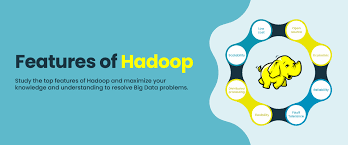comprehensive guide to Hadoop: Tackling Big Data Challenges 2024
In the era of digital transformation, organizations are inundated with vast amounts of data from diverse sources. Managing this Big Data, characterized by its Volume, Variety, and Velocity, requires specialized tools and frameworks. Apache Hadoop emerges as a powerful solution, offering scalable storage and efficient data processing capabilities.
This blog introduces Hadoop, its key features, challenges it addresses, and its high-level architecture.
The Challenges of Big Data

1. Volume
- Problem: Storing terabytes (and even petabytes) of data generated daily by enterprises.
- Solution: Distributed storage systems like Hadoop’s HDFS.
2. Variety
- Problem: Handling structured, semi-structured, and unstructured data from diverse sources such as databases, social media, and IoT devices.
- Solution: Hadoop’s flexibility in processing various data formats.
3. Velocity
- Problem: Managing and analyzing data generated at high speeds, such as real-time transaction logs or sensor readings.
- Solution: Hadoop’s parallel processing capabilities using MapReduce.
Why Choose Hadoop?

Hadoop addresses the core challenges of Big Data with its unique features:
- Massive Data Handling:
- Processes vast datasets across distributed nodes.
- Support for Diverse Data Types:
- Handles structured, semi-structured, and unstructured data seamlessly.
- High-Speed Processing:
- Uses distributed computing and parallel processing for faster results.
- Cost-Effectiveness:
- Runs on low-cost commodity hardware, reducing infrastructure costs.
Key Features of Hadoop

1. Distributed Computing
Hadoop distributes both storage and computation across multiple nodes in a cluster. This enables:
- Fault tolerance: If a node fails, the data is retrieved from replicated nodes.
- Scalability: Easily add more nodes to handle increasing workloads.
2. Replication Factor
Hadoop’s Replication Factor ensures data redundancy by storing multiple copies of each data block across different nodes, guaranteeing data availability in case of failures.
3. Parallel Processing with MapReduce
The MapReduce programming model divides tasks into two phases:
- Map: Processes input data and generates key-value pairs.
- Reduce: Aggregates and processes the results from the map phase to produce the final output.
Hadoop Architecture
1. Hadoop Distributed File System (HDFS)
HDFS is the primary storage system in Hadoop. It divides large files into smaller blocks and distributes them across nodes in the cluster.
- Key Features:
- Fault tolerance with replication.
- Scalability for growing data volumes.
2. MapReduce
MapReduce handles data processing by breaking tasks into smaller sub-tasks that run in parallel on different nodes.
- Advantages:
- Efficient processing of large-scale data.
- Built-in fault tolerance.
3. Hadoop Ecosystem
Hadoop integrates with a range of tools for diverse functionalities:
- Hive: SQL-like querying.
- HBase: NoSQL database for real-time data access.
- Pig: High-level scripting for data analysis.
- Spark: In-memory data processing for faster analytics.
How Hadoop Solves Big Data Challenges
1. Data Storage
- Challenge: Storing massive datasets across multiple systems increases the likelihood of failures.
- Solution: HDFS ensures data redundancy through replication, making it fault-tolerant.
2. Data Processing
- Challenge: Integrating data from distributed systems for analysis is time-consuming.
- Solution: MapReduce processes data in parallel across nodes, significantly speeding up computations.
Applications of Hadoop
1. Retail
- Use Case: Customer behavior analysis and personalized recommendations.
- Impact: Improved customer satisfaction and sales.
2. Healthcare
- Use Case: Analyzing patient records for predictive healthcare.
- Impact: Better diagnostics and treatment outcomes.
3. Financial Services
- Use Case: Fraud detection and risk management.
- Impact: Reduced fraud losses and enhanced decision-making.
4. Telecommunications
- Use Case: Network optimization and call data analysis.
- Impact: Enhanced service quality and reduced downtime.
Advantages of Hadoop
- Cost-Effective:
- Uses commodity hardware to reduce infrastructure costs.
- Fault Tolerance:
- Automatic data recovery ensures reliability.
- Scalability:
- Easily accommodates growing data volumes by adding nodes.
- Flexibility:
- Processes diverse data formats and sources.
Limitations of Hadoop
- Latency:
- Batch-oriented processing is slower for real-time tasks.
- Complex Programming:
- Requires expertise in Java or other supported languages for MapReduce.
- High Disk I/O:
- Relies heavily on disk operations, which can slow down certain tasks.
Future of Hadoop

Hadoop continues to evolve with new advancements and integrations:
- Cloud Integration:
- Hadoop is increasingly deployed on cloud platforms like AWS, Azure, and GCP.
- AI and Machine Learning:
- Integration with AI and ML frameworks enhances predictive analytics.
- Real-Time Processing:
- Combining Hadoop with tools like Apache Kafka enables real-time analytics.
Conclusion
Hadoop has revolutionized how organizations handle and process big data. By providing scalable storage, efficient processing, and fault tolerance, it empowers businesses to unlock the potential of their data. Whether it’s analyzing customer behavior, detecting fraud, or optimizing networks, Hadoop offers a robust foundation for modern data analytics.
Are you ready to leverage the power of Hadoop? Start your journey into big data analytics today!